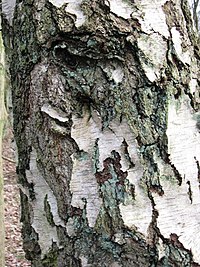Read the following passage on one First Nations artist who makes her unique art from the bark of birch trees:
| “
|
Angelique Levac sits in her native arts shop in downtown Prince George, surrounded by some of the most unusual art and crafts. Yet the most unique objects for sale are the birch bark bitings that she makes herself. So rare is this art that Angelique is one of the very few artists still working in this ancient Cree art form. Footnote…Angelique Levac knew of only two other artists that worked in the traditional Cree art of birch bark biting, and one of these, her teacher, Angelique Merasty died in Saskatoon, Saskatchewan, December 1995. [1]
She remembers how, in her childhood, she became exposed to the art of birch bark biting:
In the early days on the prairie, the Cree would set trap lines and occupy themselves with making vessels from the birch bark and even slipping off layers to make designs. These designs were used to list full geometric patterns, which would be used in porcupine sewing. [2]
Sewing with porcupine quills would seem to have had a long tradition in eastern Canada. Some documents indicate the Micmac used quills for ornamenting birch bark baskets at least as far back as the eighteenth century. Footnote…Ruth Homes Whitehead, Micmac Quillwork, The Nova Scotia Museum, 1982, p.175. Patterns were drawn on the vessel surfaces and these marks were then sewn with dyed quills. Perhaps it was during the preparation of the bark that loose layers were stripped away and used as an early paper for marking out designs. Since the inner layers of bark were fine enough to be folded, radial geometric patterns could readily be attained through biting the material. But it was in the northern Woodlands that the first birch bark flourished as an art form on its own. [3]
How did the Woodland artists come to bite their designs in the bark layer? Possibly the method originated in a pre-tool period and continued as the first and best way to leave a pattern of marks. At some point, the bitten designs began to be considered as art works in their own right. During the 1700s, some of the Woodland people, such as the Cree, migrated to the plains and so dispersed the art of birch bark biting. [4]
|
”
|

Chris Reynolds, 2009, Bark on Old Silver Birch Tree, Geograph project collection
After reading the passage, consider the following questions about Angelique Levac’s unique art form:
- Where do you think the idea for making designs on birch bark came from originally?
- What do you think would be the “tool” to make the designs on the birch bark?
- What type of designs do you think would come from this method of making art?
Do an internet search for Angelique Levac and then comment on her unique art work in the course feed.
You must be logged in to post to WEnotes.
Note: Your comment will be displayed in the course feed.
Notes
- ↑ From an interview with Angelique Levac, Prince, British Columbia, 24 February and 13 March 1996
- ↑ Interview with Angelique Levac
- ↑ “Biographic Notes,’ Angelique Levac, 1995
- ↑ Lloyd Bennett “Unique Native Art Forms”, 2nd edition (New York, Linus, 2013) p. 10
Natural Material and Indigenous Art
First Nations artists have been going to the land and their natural surroundings `for their materials to make art for many years. Natural materials that First Nation artists use in their work include:
Birch Bark Biting
Read the following passage on one First Nations artist who makes her unique art from the bark of birch trees:
She remembers how, in her childhood, she became exposed to the art of birch bark biting:
In the early days on the prairie, the Cree would set trap lines and occupy themselves with making vessels from the birch bark and even slipping off layers to make designs. These designs were used to list full geometric patterns, which would be used in porcupine sewing. [2]
Sewing with porcupine quills would seem to have had a long tradition in eastern Canada. Some documents indicate the Micmac used quills for ornamenting birch bark baskets at least as far back as the eighteenth century. Footnote…Ruth Homes Whitehead, Micmac Quillwork, The Nova Scotia Museum, 1982, p.175. Patterns were drawn on the vessel surfaces and these marks were then sewn with dyed quills. Perhaps it was during the preparation of the bark that loose layers were stripped away and used as an early paper for marking out designs. Since the inner layers of bark were fine enough to be folded, radial geometric patterns could readily be attained through biting the material. But it was in the northern Woodlands that the first birch bark flourished as an art form on its own. [3]
How did the Woodland artists come to bite their designs in the bark layer? Possibly the method originated in a pre-tool period and continued as the first and best way to leave a pattern of marks. At some point, the bitten designs began to be considered as art works in their own right. During the 1700s, some of the Woodland people, such as the Cree, migrated to the plains and so dispersed the art of birch bark biting. [4]
After reading the passage, consider the following questions about Angelique Levac’s unique art form:
Do an internet search for Angelique Levac and then comment on her unique art work in the course feed.
You must be logged in to post to WEnotes.
Note: Your comment will be displayed in the course feed.
Notes
Content is available under the
Creative Commons Attribution Share Alike License.
Privacy Policy | Authors